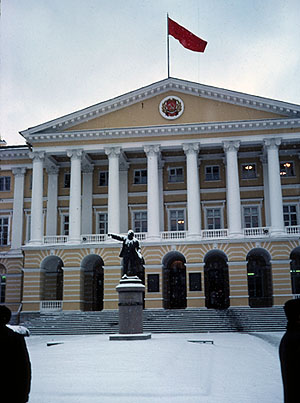HIS 112
Unit 8: Russia in Revolt

|
A snow-covered statue of Lenin stands in front of the former Smolny Institute in St. Petersburg. This former girls institute, aka the Institute for Noble Maidens, was founded by Catherine the
Great and later served as the Bolshevik Headquarters during the October Revolution of 1917--kind of ironic, huh? The actual building was constructed between 1806-1808. After the Revolution, Smolny remained the city's communist party headquarters until 1991. It is now the office of the St. Petersburg mayor. See some additional photos. |
 What you must do in this unit
What you can do in this unit
What you must do in this unit
What you can do in this unit
- Check out this website on the situation of the large Jewish population in the Russian Empire, Beyond the Pale: The History of Jews in Russia.
- Have a look at The Russian Revolution (part of Wikibooks: World History) and The Russian Revolution (part of Boundless World History)
- Ever wonder why the new
Bolshevik regime did not get along well with the rest of the
world. Professor Hammond had a short lecture in which he
explained some of the reasons for that hostility. (*.pdf file).
- Carla Spence, former student, has created a timeline on the February Revolution (1917).
- You can also read the account of Bolshevik activities in Siberia during the Civil war that was published by John Embry. On one
had, the account is a good example of the hysterical publicity that the
Bolsheviks generated in the United States and Western Europe. On
the other hand, the account is a good indication of the savagery with
which the Russian civil war was waged.
Some videos that you can watch for this unit
Extra Credit Options
- For up to 50 points of extra credit, submit the Simpler St. Petersburg Map Assignment paper. If you wish to attempt the Harder St. Petersburg Map Assignment (100 points) instead, please contact your instructor.
- For up to 25 points of extra credit, write a one-page paper (maybe
two pages if they are exceptional) that provides a detailed comparison of the
U.S. Declaration of Independence and the Russian Declaration of the Rights of
the Russian People.
- For up to 10 points of extra credit, read the Franco-Russian Alliance Military Convention (1892)
and write a paragraph that answers the question: How did this Convention fit into the
pre-1914 diplomatic scene?
- For up to 10 points of extra credit, read a newspaper account of
the Kishinev pogrom and write a paragraph explaining the impact of the pogrom
on Kishinev.
- For extra credit of a maximum of 5 points,
you can submit the answers to the Russian Declaration of the Rights of the Russian People study questions. Please write in formal, complete sentences.
- For extra credit, please suggest a
relevant website for this unit of the course. Send your instructor the title of the site, the URL and a brief explanation why you find the information interesting and applicable to the material being studied this unit.
Unit Learning Objectives
- Upon successful completion of this unit, you will be able to (1) demonstrate a knowledge of the important historical developments of the Russian Revolutions of 1917 and the ensuing civil war (2) provide some factors contributing to the successful seizure of power by the Bolshevik party and (3) analyze a historical primary source.
|

